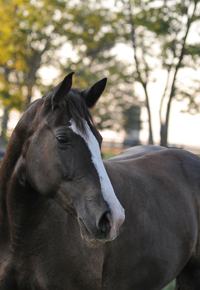At long last, November is here. I don’t just love November because it’s finally cool enough for my draft blood or because my hay and grain rations start increasing (though that’s a big part of it, I’ll be honest). I love it because it’s the start of #NoStirrupNovember.
Frankly, I don’t think no-stirrup work should be confined to a single month, and I’ve always wondered why you people decided if it was going to be celebrated in one month, it should be at the very end of your show season. That’s Human logic for you. No matter. It’s better than nothing.
If your Human is gearing up to participate in #NoStirrupNovember, I have a few suggestions on how to guide those critical lessons.
• First, sign the Human up for the Chronicle’s #COTHLoseTheLeathers challenge. If you and your Biped ride at least 12 times in November, for at least a portion of the ride, without stirrups, you can be entered into a drawing for prizes. The first 500 riders who submit a completed form tracking their rides beginning Dec. 1, will receive a ribbon. Learn more at the COTH Lose The Leathers Facebook group.
Personally, I don’t agree with giving Humans participation ribbons for simple things like, essentially, “not dying.” I think it reinforces their learned helplessness. But they’re not reasonable when it comes to ribbons, as we all know, and anything that encourages them to better themselves ultimately helps us.
• Second, log onto Amazon Prime and send your Biped enormous quantities of aspirin. She’s going to need it, and if she doesn’t get it, you’re going to have to listen to her complaints.
ADVERTISEMENT
• Once your Human realizes there’s a challenge to be had, she’s likely to dive in a little too enthusiastically. She’s also unlikely to realize just how weak her legs are at first. “Just one more trot circle, Jitter!” she says. Sure, kiddo. Whatever you say. I’ll remind you of this at 6 a.m. tomorrow.
• After that initial flush of excitement, the Human will suddenly develop a keen sense of her limitations (usually on the morning of Nov. 2). This is a good thing because it means she will treat you with more respect. Suddenly, every footfall in the trot will seem like an earthquake to her little jelly legs. The ground will seem perilously closer. She will become very interested in collecting the trot, though, of course, she won’t have the leg strength to accomplish this properly. As long as she’s still walking around on wet noodles, you can get away with a casual shuffle.
• #NoStirrupNovember is also a good time to renew your commitment to self-care. As a trainer, I know I often find myself mentally and physically exhausted during a difficult lesson. #NoStirrupNovember is just the time to begin inserting sanity breaks (or as the Human calls them, “walk breaks”) into your flatwork to give yourself a breather. Ignore the vague twitching you may feel from above when this happens. I’m sure it’s nothing.
• After a solid week of no-stirrup work, the Biped will regain confidence.
Do not stop your Quarter Horse Shuffle. No matter what she thinks, she cannot handle a full-on Dressage Queen Extended Trot. She is no DQ, my friend.
It’s possible that at this point she’ll think she’s ready for a trot-canter transition. She’ll also believe that the more instantaneous transition, the better chance she has of riding it out. This is false, of course. If you moved into the canter with your shoulder uphill, she’d go sailing back off your rump like she’d been clotheslined. Much safer to run into the transition, gradually increasing speed like a plane on the runway. And, much like a plane, she’ll find that when her teeth start rattling the hardest, she’s just about to take off. That’s how to make sure she’s grateful when the canter finally arrives.
ADVERTISEMENT
• Keep in mind that not all Humans will be able to tough out the canter transition at all. They become very slippery during this portion of their training, sliding off left, right and center. Fortunately, I’ve found that when they are working without stirrups, they tend to roll down my shoulder like a glob of snot down a toddler’s face. This softens the impact, making it easier for the Human to roll a few feet, blow her nose, and try again. Part of learning, as we all know, is trial and error.
• The Human will have an easier time in the canter than she did in the trot, but the downward transition is often a doozy. Much safer to skip the trot (and walk) and stop altogether. Just make sure to keep your head down in case she isn’t able to catch herself fast enough. No sense in losing a chunk of mane in the name of education.
• After the ride is over (either because she’s fallen off or because she’s given up), really play up the “Cuddly Pony” routine to make sure you get maximum cookies for your efforts. After all, she should be feeling grateful to you for your gentle, loving care. She’s alive, isn’t she?
 |
Jitterbug is a Michigan-bred Professional Draft Cross who skillfully avoided saddles until age 5. Since then, she has been lauded for her talent in successfully managing humans while training herself to one day achieve eventing greatness. Jitter and her human live in central Kentucky. Read all of Jitter’s COTH columns. Follow Jitterbug on Facebook! Photo by Dark Horse Photography. |
Thank you to the prize donors for the Chronicle’s #LoseTheLeathers challenge. They include:
Kickapoo Ponies
Hollins University
Tucker Tweed
Straight Arrow
Prestige
Country And Stable
TattersallFox
Farnam















